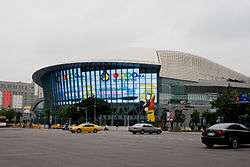LED display

An LED display is a flat panel display, which uses an array of light-emitting diodes as pixels for a video display. Their brightness allows them to be used outdoors in store signs and billboards, and in recent years they have also become commonly used in destination signs on public transport vehicles. LED displays are capable of providing general illumination in addition to visual display, as when used for stage lighting or other decorative (as opposed to informational) purposes.
History
The first true all-LED flat panel television screen was possibly developed, demonstrated and documented by James P. Mitchell in 1977.[1] The modular, scalable display was initially designed with hundreds of MV50 LEDs and a newly available transistor-transistor logic memory addressing circuit from Texas Instruments.[2] The ¼-inch thin flat panel prototype and the scientific paper were displayed at the 29th ISEF expo in Washington D.C. in May 1978.[3] It received awards by NASA[4] and General Motors Corporation.[5] A liquid crystal display (LCD) matrix design was also cited in the LED paper as an alternative x-y scan technology and as a future alternate television display method. Additional recognition was provided by Westinghouse Educational Foundation "Honors Group" and the concept prototype was also a selected scientific paper at the Iowa Academy of Science of the University of Northern Iowa. The replacement of the 70 year+ high-voltage analog system (cathode-ray tube technology) with a digital x-y scan system has been a significant achievement. Displacement of the electromagnetic scan systems included the removal of inductive deflection, electron beam and color convergence circuits. The digital x-y scan system has helped the modern television to “collapse” into its current thin form factor.
The 1977 model was monochromatic by design. Efficient blue LEDs did not arrive for another decade. Large displays now use high-brightness diodes to generate a wide spectrum of colors. It took three decades and organic light-emitting diodes for Sony to introduce an OLED TV, the Sony XEL-1 OLED screen which was marketed in 2009. Later, at CES 2012, Sony presented Crystal LED, a TV with a true LED-display (in which LEDs are used to produce actual images rather than acting as backlighting for other types of display, as in LED-backlit LCD displays which are commonly marketed as LED TVs).
The 2011 UEFA Champions League Final match between Manchester United and Barcelona was broadcast live in 3D format in Gothenburg (Sweden), on an EKTA screen. It had a refresh rate of 100 Hz, a diagonal of 7.11 m (23 ft 3.92 in) and a display area of 6.192×3.483 m, and was listed in the Guinness Book of Records as the largest LED 3D TV.[6][7]


See also
References
- ↑ Mitchell's modular LED x-y (horizontally and vertically digitally scanned array system) was cited in the 29th International Science and Engineering Exposition "book of abstracts", p. 97, published by the "Science Service", Washington D.C. May 1978.
- ↑ A technical reference detailing the LED display array, RF interface and scanning circuit was included as part of the 1978 29th ISEF exhibition in Anaheim, CA.
- ↑ The prototype and scientific paper "Light Emitting Diode Television Screen" were part of exhibit #635.
- ↑ 29th ISEF "Announcement of Awards", p. 4, May 13, 1978, published by the Science Service, 1719 N Street Washington D.C. 20036.
- ↑ 3rd Grand Award – GM, corporate sponsor of the 1978 Science Service event. 1978 29th Annual ISEF "Announcement of Awards", p. 5, (note: Intel Corporation is the current sponsor of this event).
- ↑ EKTA’s Ukrainian produced 3D Led TV makes The Guinness Book of World Records, www.ekta-led.com
- ↑ Largest LED 3D TV. guinnessworldrecords.com
External links
![]() Media related to LED displays at Wikimedia Commons
Media related to LED displays at Wikimedia Commons
| ||||||||||||||||||||||||||||||||